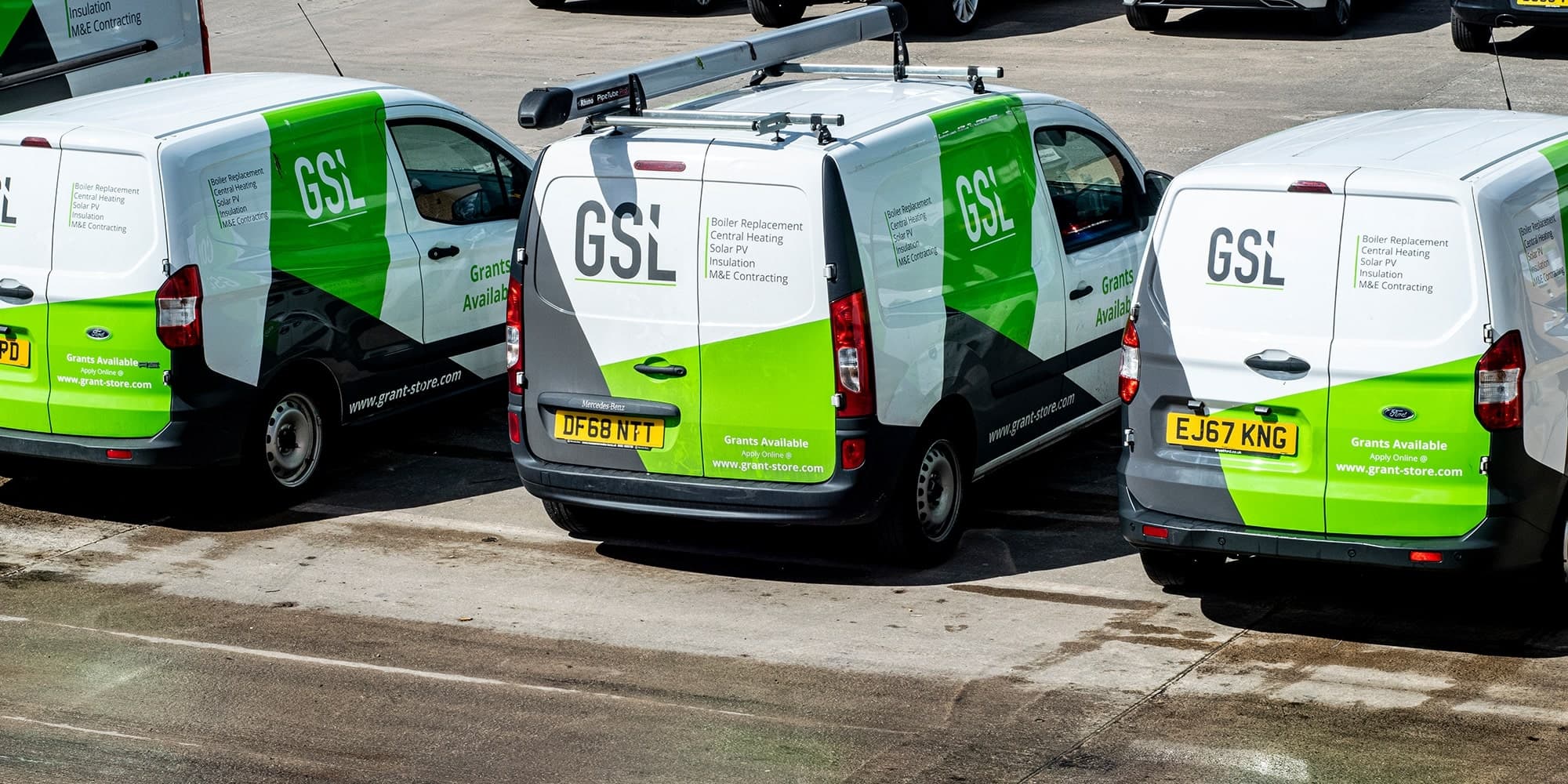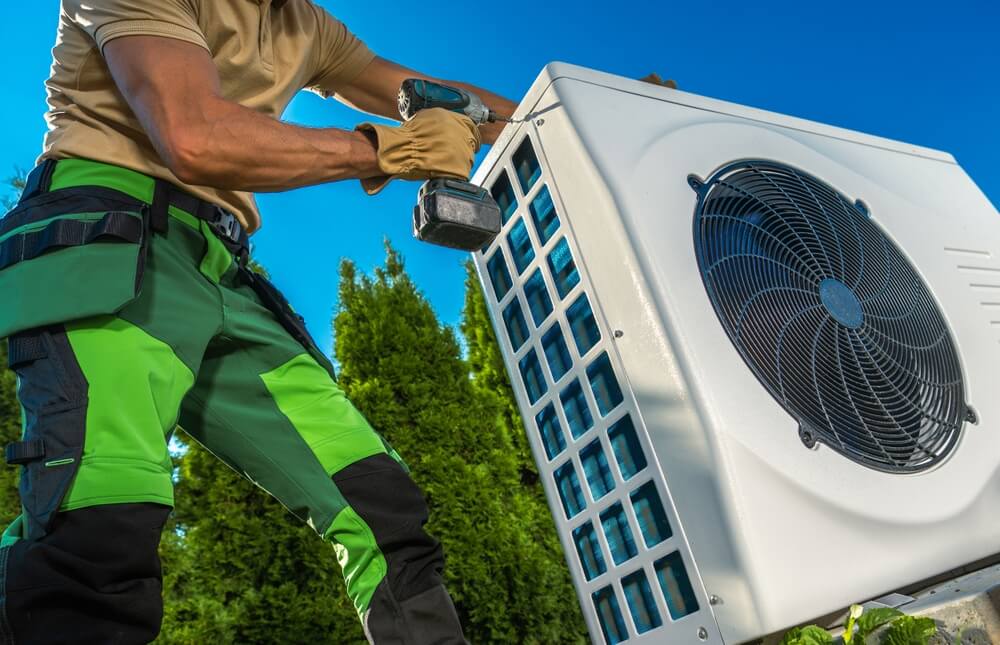August 6th, 2025
How 900m2 of solar panels are helping this NHS hospital go carbon neutral
Written by: Puneet Verma
News
Switching to an air source heat pump (ASHP) is a fantastic way to live more sustainably while also lowering your home’s energy bills.
With rising electricity costs and a bigger focus on moving away from fossil fuels to protect the planet, more homeowners are considering this as an alternative to traditional heating systems. But what exactly does installing an ASHP involve?
In this blog post, we’ll walk you through the entire process, from the initial site survey to the final post-installation steps, so you know what you can expect.
Key Takeaways
The process for installing a heat pump varies depending on the type of heat pump you want.
Generally, installing an air source model is quicker and easier than a ground source heat pump installation. That being said, whether you want one to improve your central heating or support your traditional boiler, there are three key phases that will be found in any project:
Let’s take a look at each in a little more detail.
Before the installation begins, your heat pump installer will carry out a thorough site survey to figure out if your home is suitable.
This involves heat loss calculations to figure out the right size and type of heat pump for your property.
The size of your home, the quality of insulation, and your specific heating needs are all taken into account.
Your installer will then design a system tailored to your home, specifying what you’ll need, including:
This pre-installation phase makes sure the system is designed to be as efficient and effective in your specific property as possible.
The installation of an air source heat pump involves several steps. Let’s break them down so you can get a better idea of what to expect.
The outdoor unit can be installed on a base or on a wall bracket, and is connected to your home’s heating pipes.
The indoor part of the system includes:
These units are interconnected through refrigerant lines and electrical wiring, which can sometimes involve drilling through walls.
During this stage, your heat pump installer will make sure everything is connected properly, from the outdoor unit to the indoor heating elements so that you can enjoy seamless heating throughout your entire home from the get-go.
Once the installation is complete, your new heat pump system is thoroughly tested to make sure it meets the highest standards. Your installer will also walk you through the air source heating system, explaining how to use the controls and thermostats.
While air source heat pumps need only low maintenance, it’s important to keep the filters and fans clean to make sure the system stays efficient.
Your installer may offer a maintenance package to help with this, but regular check-ups can be enough to keep your heat pump working well. Done properly, air source heat pumps can often last over 20 years.
Are you interested in booking your own heat pump installation?
While it might be tempting to DIY your installation to save money, this process is complex and needs expertise that can only come from a trained professional.
Certified installers, like those accredited by the Microgeneration Certification Scheme (MCS), make sure the installation complies with industry standards and runs smoothly. They handle everything from the initial assessment to the final commissioning, giving you peace of mind that your system will function efficiently for years.
Our team at Grant Store is fully accredited and certified, so if you’re looking for an installer you can trust, there’s no better name to turn to.
There’s no one size fits all answer to this question, as it depends on your property and where your heat pump is going to be installed. For example, if there is easy access to the location, it can be a faster process compared to if the heat pump is in a tricky spot. Once we have the full details of your project, we’ll be able to give you an accurate estimate.
At Grant Store, our heat pump installers have years of experience and are MCS certified. This means you can trust us to carry out the work in the most efficient way, without compromising on quality. We will always aim to cause the least amount of disruption to your daily life as possible.
The best place for your air source heat pump is somewhere outside with plenty of air flow. It should sit on a solid, level base – like a concrete slab – with at least a meter of space around it. Try to place it close to your home to keep pipework short and energy loss low, and make sure it’s easy to access for regular servicing.
Installing an air source heat pump is a big step towards a greener, more energy-efficient home. It involves careful planning, professional installation, and ongoing maintenance, but the benefits are well worth it.
Not only will you be reducing your carbon footprint, but you’ll also be future-proofing your home against rising energy costs and potential bans on traditional gas boilers. Worried about the initial cost? Give our team a call.
We can help you figure out what funding you might be eligible for, help you apply and manage the full installation. With years of hands-on experience, you can count on our expertise and 5-star service to get the job done right. Reach out today to get started.
August 6th, 2025
How 900m2 of solar panels are helping this NHS hospital go carbon neutral
Written by: Puneet Verma
News
August 6th, 2025
What is a solar panel inverter?
Written by: Puneet Verma
News
June 9th, 2025
Solar water heating vs solar PV: What’s right for you?
Written by: Gareth Whitehill
News
May 9th, 2025
Solar panel installation: Step-by-step guide for UK homes & businesses
Written by: Gareth Whitehill
News
April 9th, 2025
Are solar batteries worth it in the UK?
Written by: Gareth Whitehill
News
April 9th, 2025
What size solar battery do I need?
Written by: Gareth Whitehill
News
January 20th, 2025
Heat pumps vs. traditional heating: Which is right for your home?
Written by: Gareth Whitehill
Heat Pumps
January 13th, 2025
Do heat pumps work well in older homes?
Written by: Gareth Whitehill
Heat Pumps
January 6th, 2025
How do air source heat pumps work?
Written by: Gareth Whitehill
Heat Pumps
December 30th, 2024
Are air source heat pumps worth it in the UK climate?
Written by: Gareth Whitehill
News
December 23rd, 2024
Why are heat pumps taking over UK homes?
Written by: Gareth Whitehill
Heat Pumps
December 16th, 2024
Are heat pumps suitable for smaller homes?
Written by: Gareth Whitehill
Heat Pumps
September 25th, 2024
Grant Store are official sponsors of Chorley FC!
Written by: Gareth Whitehill
News
August 30th, 2024
Grant Store is an official Octopus Trusted Partner!
Written by: Gareth Whitehill
News
August 1st, 2024
How green is solar energy?
Written by: Gareth Whitehill
Solar
July 30th, 2024
How to insulate an old house
Written by: Gareth Whitehill
News
July 29th, 2024
What’s Involved in an Air Source Heat Pump Installation?
Written by: Gareth Whitehill
Heat Pumps
July 28th, 2024
A complete guide to heating water with solar power
Written by: Gareth Whitehill
Solar
July 25th, 2024
How To Make the Most Out of ECO4 Funding
Written by: Gareth Whitehill
News
July 23rd, 2024
Are UK homes getting any greener?
Written by: Gareth Whitehill
News
June 27th, 2024
Why should you choose an MCS installer for your heat pump project?
Written by: Gareth Whitehill
Heat Pumps
June 27th, 2024
When does ECO4 end, and what happens next?
Written by: Gareth Whitehill
News
June 11th, 2024
Exploring Energy Grants for Pensioners: A Guide to Lowering Your Energy Costs
Written by: Gareth Whitehill
News
June 11th, 2024
Do air source heat pumps work well with solar panels?
Written by: Gareth Whitehill
Heat Pumps
June 11th, 2024
Your Guide to Understanding Energy Performance Certificates (EPCs)
Written by: Gareth Whitehill
News
June 11th, 2024
What energy grants can I get on Universal Credit?
Written by: Gareth Whitehill
News
June 1st, 2024
Who qualifies for a boiler grant in the UK?
Written by: Gareth Whitehill
News
May 22nd, 2024
Is the UK Government Planning to Ban Gas Energy?
Written by: Gareth Whitehill
News
April 25th, 2024
Your Complete Guide To Off-Gas Property Grants in the UK
Written by: Gareth Whitehill
News
April 24th, 2024
What are electric storage heaters?
Written by: Gareth Whitehill
News
April 23rd, 2024
How To Improve Your Home’s EPC Rating: A Guide to Boosting Efficiency and Reducing Costs
Written by: Gareth Whitehill
News
April 23rd, 2024
What is the ECO Scheme, and how can it help me?
Written by: Gareth Whitehill
News
April 23rd, 2024
How to apply for the ECO4 Grant: Everything you need to know
Written by: Gareth Whitehill
News
April 18th, 2024
The Complete Guide to Heat Pumps: Benefits, Costs, Savings, and Efficiency
Written by: Gareth Whitehill
Heat Pumps
March 13th, 2024
What size solar PV system do I need?
Written by: Gareth Whitehill
Solar
February 27th, 2024
What grants are available for energy-saving?
Written by: Gareth Whitehill
News
November 24th, 2023
How Many Solar Panels Do I Need?
Written by: Gareth Whitehill
Solar
November 23rd, 2023
How Much Money Do Solar Panels Save?
Written by: Gareth Whitehill
Solar
November 22nd, 2023
How Are Solar Panels Made?
Written by: Gareth Whitehill
News
November 22nd, 2023
Do you need planning permission for solar panels?
Written by: Gareth Whitehill
News
November 22nd, 2023
How Much Do Solar Panels Cost?
Written by: Gareth Whitehill
News
November 22nd, 2023
How Do Solar Panels Work?
Written by: Gareth Whitehill
News
November 20th, 2023
Smart Export Guarantee Rates 2024
Written by: Gareth Whitehill
News
November 20th, 2023
Can I Add a Battery to my Solar System?
Written by: Gareth Whitehill
News
November 20th, 2023
How Do You Store Solar Energy?
Written by: Gareth Whitehill
News
October 3rd, 2023
Solar panels: are they worth the cost?
Written by: Gareth Whitehill
News
September 19th, 2023
How efficient are solar panels?
Written by: Gareth Whitehill
News
September 19th, 2023
Do solar panels boost home value?
Written by: Gareth Whitehill
News
September 19th, 2023
What are the pros and cons of solar panels?
Written by: Gareth Whitehill
News
Not sure which energy-saving solution is right for your home? Or do you have questions about grant eligibility? Our team has the answers. Give us a call and we'll help you figure everything out.
Call us now on:
01942 918 844
"*" indicates required fields
